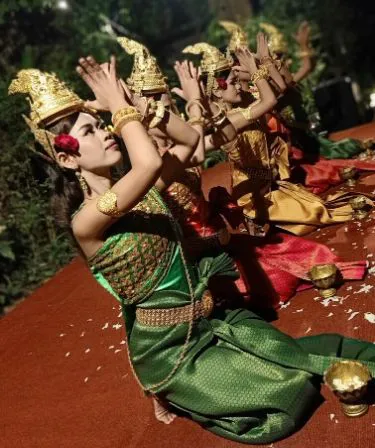For your next trip to Siem Reap, why not get traditional? Learn all about the Apsara dance before seeing it in action.
For your next trip to Siem Reap, why not get traditional? Learn all about the Apsara Dance before seeing it in action.
Cambodia has a rich artistic culture, much of which remains in the nation’s present day. Music, illustration and dance are all a part of the recipe, and there’s value in every ingredient.
At Anjali by Syphon, we do our best to help Cambodia sustain its culture. That’s why we host an Apsara dance performance for our guests to enjoy while they eat dinner at Hunkaar Table & Lounge. Until you get the chance to see it for yourself, here’s a sneak peek on all things Apsara dancing.
What is Apsara Dance?
The short version: Apsara dancing is a Cambodian style of ballet. It’s a classical dance and held in high regard throughout the nation.
The long version: Apsara dancing dates all the way back to the seventh century. Dancers use Apsara to tell the tales of Cambodian’s unique Buddhist and Hindu mythology. Head to Sambor Prei Kuk temple in Cambodia’s Kampong Thong province and you’ll see stone carvings of dancers from more than a thousand years ago. The longevity of this ethereal movement is evidence of influence, no matter where you are in Cambodia’s confines.
The Apsaras Who Started it All
According to Hindu and Buddhist mythology, an Apsara is a female spirit that lives in the clouds and water. They visit Earth to entertain gods and kings, using none other than the prowess of their captivating movements.
So where do the Apsaras hail from? The churning of the ocean of milk, of course. The samuda manthan—also known as the ko samut teuk dos in Khmer language—is a mythological place that breeds beauty and grace.
If you make your way to Angkor Wat, you can see Apsara legend for yourself. The story is carved on a 49-meter bas relief at the world’s largest religious monument.
Apsaras are like nymphs. They’re charming, beautiful and irresistible. That’s exactly what Cambodian dancers in the modern age aim to portray with every ounce of their being.
Did you know? It’s believed that Khmer King Jayavarman VII had more than 3,000 Apsara dancers in his court.
Apsara in the Modern Age
Head to an Apsara dancing show and you’ll see slow, methodical movements meant to mesmerise the audience in a hypnotic trance. Most of the movements take place in the hands and feet, and each one is totally nuanced.
Thousands of gestures—called kbach—make up the art, each of which has a meaning all its own. Whether it be a reference to something in nature or an allusion to Buddhist or Hindu mythology, this art form is teeming with symbolism.
Apsara dancers wear beautiful headdresses and ornate attire. They glitter from the stage, always keeping a slight smile but never opening their mouths. Their costumes are crafted from silk and jewels, enrapturing audiences from all over the globe with utter beauty.
Even though most of Cambodia’s artists were killed during the Khmer Rouge reign, a few Apsara dancers survived. These noble individuals passed on the art form as soon as they could, allowing Apsara to thrive even after the worst of tragedies.
Dinner and a Show at Hunkaar Table & Lounge
No trip to Cambodia is complete without an Apsara dance experience. That’s why Anjali is proud to offer our very own dinner performance.
Hunkaar Table & Lounge is a place where you can find the perfect amalgam of asian and western cuisine. As you eat, revel in an Apsara dance performance that will change your view of Hindu and Buddhist culture forever.

